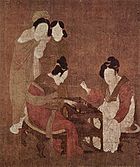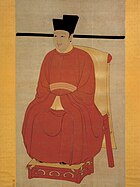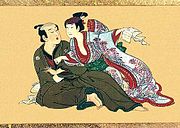Painting of Central Asia: Chinese Painting and Japanese Painting
Painting of Central Asia

Women playing double sixes, by Zhou Fang (730-800 AD Av), China.
The China, the Japan and Korea have a great painting tradition that is strongly committed to the art of calligraphy and engraving. The traditional painting in the Far East is characterized by techniques of painting with water, less realism, subjects "elegant" and stylized, a graphical approach to describing the importance of white space (or space negative) and a preference for landscapes rather than human figures. Besides painting the ink and the use of color on rolls of paper or silk, gold on lacquer was also a medium commonly used in Asian painting. While the silk was a medium rather expensive, the invention of paper in the first century BC. AD by Cai Lun, the eunuch of the Han dynasty, has provided support not only cheap and popular for writing, but also for painting.
The Confucianism of Taoism and Buddhism have played an important role in the art of Central Asia. The medieval painters of the Song dynasty, such as Lin Tinggui the twelfth century are excellent examples of the integration of Buddhist ideas in the Chinese painting classic. At the end of the nineteenth century with the development of Japonisme, artists impressionists like Van Gogh, Henri de Toulouse-Lautrec and Whistler admired traditional Japanese artists of Ukiyo-e as Katsushika Hokusai and Hiroshige, and their work has been influenced.
Chinese Painting

Painting of the XVIII century reproduction of an original painting from the twelfth century by the Chinese painter Zhang Zeduan.

One autumn morning in the Han Palace, by the painter Qiu Ying in the Ming Dynasty.
The earliest works of Chinese painters date back to the period of Warring States (481 - 221 BC.), With paintings on silk or tombs, stone, brick, or stone. They were generally simplistic stylized forms with rudimentary geometric patterns. These paintings often depicted mythological creatures, domestic scenes, scenes of work or scenes full of sumptuous royal officials. At this time, and subsequently under the Qin Dynasty (221 - 207 BC.) And the Han Dynasty (202 BC. - 220), the painting was not a means of 'personal expression, but rather a way to symbolize and honor the geomancy, funerary rites, representations of mythological gods or spirits of ancestors, etc..
Under the Han dynasty, paintings on silk representing court officials and domestic scenes rubbed hunting scenes with men on horseback or engaged in military parades. There were also paintings on figurines and statues, like those covering the statues of soldiers and horses in the Mausoleum of Emperor Qin. Under the Eastern Jin Dynasty (316 - 420) based in Nanjing, the painting became a hobby of official officials, aristocrats and bureaucrats Confucian educated, just as the music played on the zither guqin, the calligraphy and poetry. The painting became a form of artistic expression and free at that time, the court painters were part of the social elite.

Painting rollers Gu Kaizhi.
The painter Gu Kaizhi (344 - 406) of the Eastern Jin Dynasty is one of the most celebrated artists of Chinese history is very well the development of classical Chinese painting. As paintings roll Kaizhi, Chinese artists of the Tang Dynasty (618 - 907) as Wu Daozi painted works colorful and very detailed on horizontal rollers. The paintings from the Tang period represented an environment and idealized landscapes with so sparse, objects or people. An artist like Zhan Ziqian at the beginning of the Tang era, painted beautiful landscapes with a style that makes him a precursor of realism. However, landscape art reached its highest level of maturity and realism during the period of Five Dynasties and Ten Kingdoms (907 - 960) with exceptional artists such as Dong Yuan and Gu Hongzhong.

A portrait of the emperor Huisong of the Song Dynasty
With the Song Dynasty (960 - in 1279), not only the art of landscape has improved but at the same time, painting portraits became more standardized and sophisticated than before to reach maturity under the Ming Dynasty (1368 - 1644). At the end of the thirteenth century and during the first half of the fourteenth century under the Yuan dynasty controlled by the Mongols, the Chinese had no right to occupy the highest posts of government were reserved for Mongols or other ethnic groups of Central Asia), and the system of the imperial examination was then abandoned for a time. Many educated Chinese who had no profession has therefore turned to art, painting and theater that mainly explains the Yuan period was one of the most vibrant eras and most abundant in painting Chinese. This was the case for example of Qian Xuan (1,235 - in 1305), which was an official of the Song dynasty, but who refused to serve the Yuan court and dedicated himself to painting. Others include the murals of the palace of Yongle covering over 1000 square meters.

Portrait of Emperor Qianlong, mid eighteenth century.
While painting stylized, surreal elegance were often preferred to realism (as in the style shanshui), Chinese painters began to make paintings more realistic in the Song Dynasty, which lasted movement then. The artists of the Ming Dynasty have developed a taste for detail and realism of nature, particularly in the description of animals (such as ducks, swans, sparrows, tigers, etc..) Or flowers and wood.
The classical Chinese painting has endured under the Qing Dynasty, with highly realistic portraits as those of Emperor Kangxi, Emperor of Yongzheng Emperor or Qianlong. Under the reign of Qianlong and until the nineteenth century, the style baroque European visibly influenced Chinese painting, particularly with the effects of shadows and lights. Conversely, the Asian paintings and other art forms, such as porcelain and lacquer were highly valued in Europe.
Japanese Painting

The Japanese painting is one of the oldest and finest art, bringing together a wide variety of genres and styles. The history of Japanese painting is a mixture and a synthesis between aesthetics and an original adaptation of ideas from outside. Thus, the Ukiyo-e (literally meaning "pictures of the floating world") is a genre of Japanese prints (or woodcuts) that incorporates the styles of paintings from the seventeenth to the twentieth century. Conversely, Japanese painting, particularly in the Edo period, exerted a great influence on Western painting, notably in France during the nineteenth century.
Like it on Facebook, Tweet it or share this article on other bookmarking websites.

